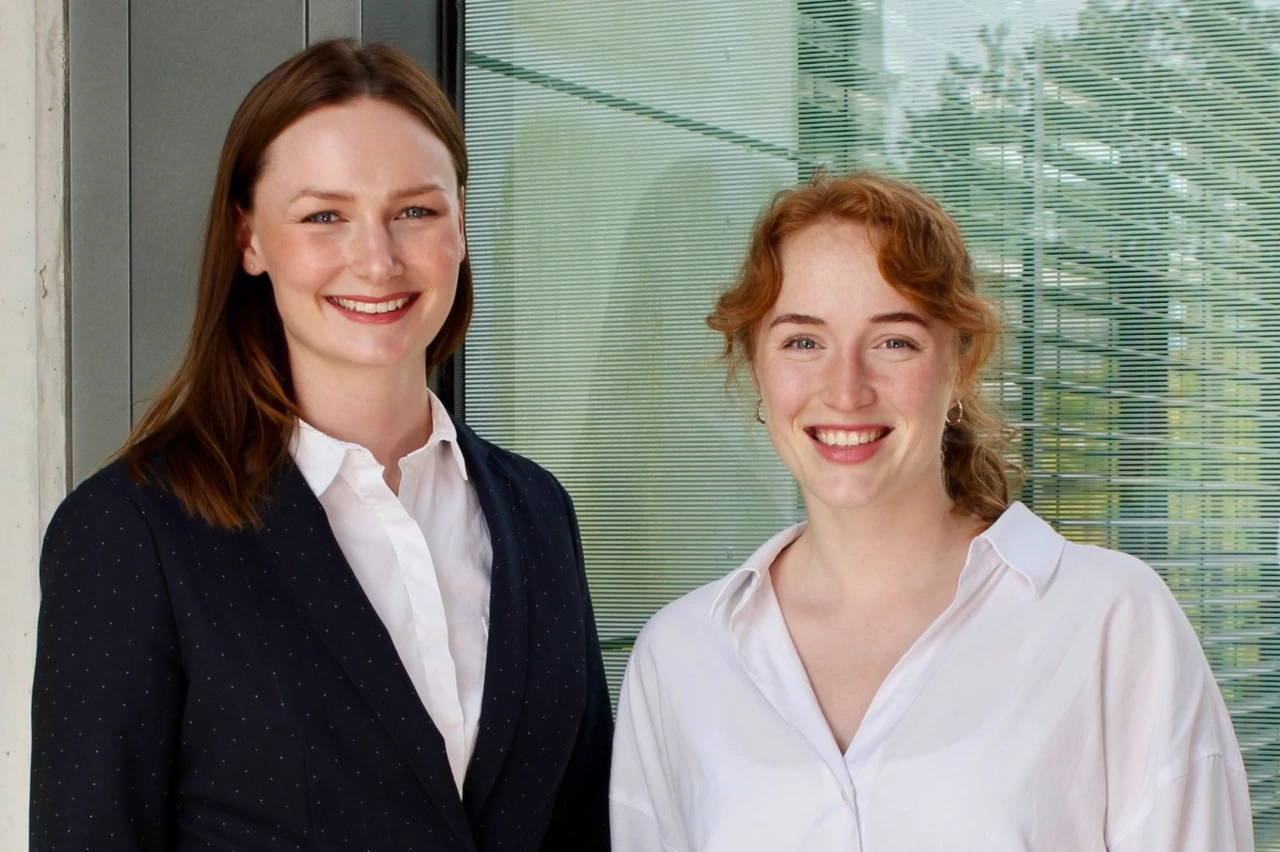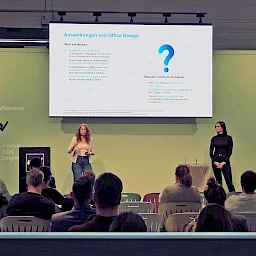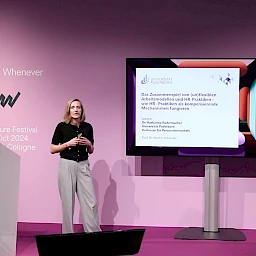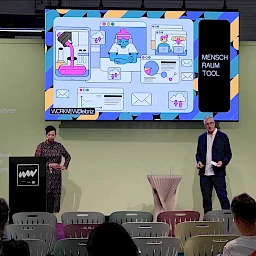The new series “The Spatial Thinkers” by Amelie Marie Fischer (University of Konstanz) and Dr Ann Sophie Lauterbach (Dresden University of Technology) for the IBA Forum will provide insights into research into the spatial design of the world of work from the largest management conference worldwide in September 2025
Why are we talking about workspaces (again) today?
Hardly any other topic currently occupies companies as much as the question of how and where do we want to work in future. In recent years, several developments have come together that have led to renewed interest in the topic of workspaces:
- Hybrid work has rendered many previous spatial concepts obsolete. If a large proportion of the workforce regularly works remotely, the question arises as to why we still need offices—and how offices should be designed to accommodate this.
- The issues of sustainability and energy efficiency require a critical examination of floorspace usage, existing buildings and the application of resources. Less is often more—but how do you downsize without a loss of culture?
- Employer branding and well-being: employees today want to work in an environment that is not only functional but also atmospherically appealing, healthy and inclusive. The space where one works thus becomes an expression of organizational values and attractiveness.
The coronavirus pandemic made many organizations realize that a workspace is not just a physical setting but also an item of central importance for culture, collaboration and identification. At the same time, organizations are under pressure to reduce space, cut energy costs and design hybrid models that are both functional and socially sustainable. Space is therefore back on the management agenda, but in a different way than before—no longer just as a question of equipment but also as a strategic factor in organizational design.
WHaT is „Organizational Space“?
Over the last two decades, a separate research field that deals with the significance of space in organizations has been established in the management research realm. This field addresses the topic known as “organizational space”. The term was deliberately chosen in order to distinguish it from “architecture” or “workplace design”, as it considers space as not primarily a built environment but rather as a socially constructed, dynamic and meaningful structure. Early philosophical perspectives already offered interesting approaches that still have an impact on management research today.
Back in 1974, for example, Henri Lefebvre described space as a product of social practices. He argued that spaces are not just backdrops but are instead constantly being created anew through the way they are used, thought about and planned. Michel Foucault also drew attention to the power relations that are inscribed in spaces. Who controls access? Who is watching whom? Who can withdraw? Space defines order—and thus also hierarchies and behaviour. Finally, there is also a distinction in research between space and place (e.g. Yi-Fu Tuan, 1975; Tim Cresswell, 2014), which emphasizes that it is only through subjective meaning that a neutral space becomes a meaningful place. A desk only becomes one’s “own” when emotional ties, routines and social relationships have come to characterize it.
What Makes up these Spaces?
These debates take place not only in a theoretical context but also at scientific conferences. At the world’s largest management conference, the Academy of Management, which took place this year in trendy Copenhagen, these topics played a very prominent role alongside (and with) technological change. Scientists and representatives from companies discussed not only the office but also all possible “in-between spaces”. And by that we really mean absolutely everything—from the time-honoured headquarters to the nomadic lifestyle in Bali. This includes working in coworking and co-living spaces and mobile working in public areas such as cafés or at home, as well as traditional office work.
Organizational scholars examine how space both reflects and shapes the dynamics of relationships and organizations through possibilities (Cnossen and Bencherki, 2019; Weinfurtner and Seidl, 2019), atmospheres (Beyes and Steyaert, 2012; Petani and Mengis, 2016) and arrangements (Beyes and Holt, 2020). We are certain that spaces need to be jointly planned and revitalized, not just once, but with continuous adjustment, in the same way as an organization, its goals and its workforce evolve. Space is simply not fixed; it is a structure that is continuously used, experienced and negotiated through everyday practices. A space without people to give it meaning remains lifeless. It is only through the attribution of meaning and social interpretation that it is transformed from a physical structure into a psychological place full of symbolism. But enough philosophising!
What questions does research ask?
The issue is clearly no longer whether space has an effect, but rather how, when and for whom it has an effect. This raises the following research questions, for example:
- What effects does the flexibility of work have on the resources of space and time?
Studies show that new spatiotemporal connections arise—not everyone is on site at the same time, spaces are shared and presence becomes strategic—and this changes visibility and participation. - How do spatial concepts affect team dynamics and leadership?
Studies suggest that open, flexible spaces can promote dialogue and interaction—but only if there are also places for retreat and clear rules of use. This presents managers with the challenge of not just using physical and digital spaces but also actively shaping them together. - To what extent can space be used as a strategic management tool?
Spatial design can influence behaviour by boosting transparency, enabling encounters and breaking open silos. At the same time, it harbours risks if control and rationalization dominate.
Practical conclusion: space as a bridge between strategy, culture and working reality
A key conclusion of current research is that spaces are never only functional containers—they should be designed with care and consideration. In times of technological transformation and shortages of skilled workers, space becomes a bridge between strategic goals (efficiency, flexibility), cultural values (trust, participation) and the concrete reality of work (tools, collaboration, well-being). Space is not only a cost factor but also a management tool, a cultural resource and a communication medium. Spaces are themselves like an organization—they arrange, connect, separate and symbolize. They shape how people position themselves in an organization—socially and emotionally. It is therefore clear that spatial design is far more than just architecture—it is organizational design in action.
What can you expect from this series?
Bringing together individual needs and collective goals in an increasingly fluid spatial and temporal environment is anything but easy. In the upcoming contributions to the IBA research series “The Spatial Thinkers”, we will present a wide range of stimulating ideas and address practical issues relating to the design of workspaces:
- What effect do different office designs actually have on employees?
- What does flexibility mean in times of working from home and from cafés?
- How can a sense of togetherness be created in digital spaces?
- How can physical spaces be designed inclusively?
- What role do status and power play in spatial design?
- And how can you measure whether a spatial design works at all?
Here, we are combining the latest scientific findings with specific recommendations for practitioners. Sounds exciting, don’t you think? Stay tuned—we’re looking forward to the series!




 IBA Forum-Gastbeitrag
IBA Forum-Gastbeitrag 



